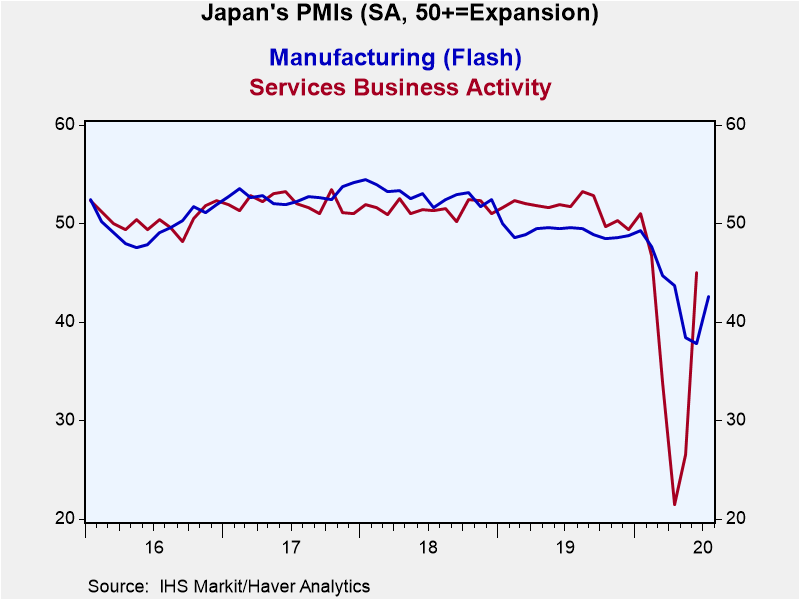 Global| Jul 22 2020
Global| Jul 22 2020Japan's PMIs Make Partial and Weak Recovery
Summary
Japan's composite PMI moved higher in July but still stopped short of the key 50 mark that represents output neutrality. While the composite index is up in July at 43.9 from 40.8 in June, the index still points to private sector [...]
 Japan's composite PMI moved higher in July but still stopped short of the key 50 mark that represents output neutrality. While the composite index is up in July at 43.9 from 40.8 in June, the index still points to private sector growth weakening – just not as fast. The queue percentile standing of this index on data back to January 2016 finds it only in its 5.7 percentile of that queue of data. There have only been four weaker readings for the composite on this timeline and all of them have come in the preceding four months to July.
Japan's composite PMI moved higher in July but still stopped short of the key 50 mark that represents output neutrality. While the composite index is up in July at 43.9 from 40.8 in June, the index still points to private sector growth weakening – just not as fast. The queue percentile standing of this index on data back to January 2016 finds it only in its 5.7 percentile of that queue of data. There have only been four weaker readings for the composite on this timeline and all of them have come in the preceding four months to July.
Japan's overall weakness is the product of nearly equal weakness in both its manufacturing and service sectors. However, manufacturing has been quite weak and consistently weak for the last year. The three-month, six-month, and 12-month averages of the manufacturing PMI show values that have slipped modestly from 46.2 over 12 months to 43.6 over six months to 40.1 over three months. Service sector gauges were even weaker to start with; they also show persistent contraction but with their profile declining from 44.3 over 12 months to 37.4 over six months and then falling to a much weaker 31.0 over three months. The service sector has been hit the hardest recently by the efforts to contain the coronavirus- we see this in other countries too as the virus is very hard on the service sector.
In July, however, manufacturing has a weak 3.8 percentile standing that is only slightly weaker than the service sector standing at its 5.7 percentile- as weakness goes this is very balanced. But in a list of 18 countries in June, Japan's manufacturing sector PMI value ranked 16th as Japan has not been able to recover as quickly as other countries have and Japan's manufacturing sector has remained relatively more troubled compared to others internationally. Only Mexico and Indonesia had weaker manufacturing PMI gauges in June compared to Japan. Japan is caught with a still weak domestic economy and weakness in its two most important trading partners who are still embroiled in trade unrest and political sparring that seem to be getting worse.
However, despite its problems, the Japanese government today has just raised its economic assessment for the second month in a row. The cabinet office comment on the situation is this: "The Japanese economy is still in a severe situation due to the Novel Coronavirus, but it is showing movements of picking up recently."
The government report claims Japanese exports are bottoming that is a positive factor for the Japanese response to external demand- and hopefully it is a correct assessment. However, the government report cautions that the coronavirus is still an active factor in Japan.
The edge up in the service sector reading from June to July is a clear indicator that some things on the domestic front may be doing better but it's not by much. The diffusion indexes continue to flag contraction across manufacturing and services and the virus is still a mitigating factor to growth and the growth outlook. Those are a lot of negatives.
The best part of the report is that there are gains in the month for both manufacturing and services in July. The biggest worry is that services have now barely improved on the month and the virus remains a threat. The coronavirus tends to hit the service sector very hard. The bare-bones improvement in services is a cautionary signal about getting too optimistic on the outlook.
Robert Brusca
AuthorMore in Author Profile »Robert A. Brusca is Chief Economist of Fact and Opinion Economics, a consulting firm he founded in Manhattan. He has been an economist on Wall Street for over 25 years. He has visited central banking and large institutional clients in over 30 countries in his career as an economist. Mr. Brusca was a Divisional Research Chief at the Federal Reserve Bank of NY (Chief of the International Financial markets Division), a Fed Watcher at Irving Trust and Chief Economist at Nikko Securities International. He is widely quoted and appears in various media. Mr. Brusca holds an MA and Ph.D. in economics from Michigan State University and a BA in Economics from the University of Michigan. His research pursues his strong interests in non aligned policy economics as well as international economics. FAO Economics’ research targets investors to assist them in making better investment decisions in stocks, bonds and in a variety of international assets. The company does not manage money and has no conflicts in giving economic advice.






